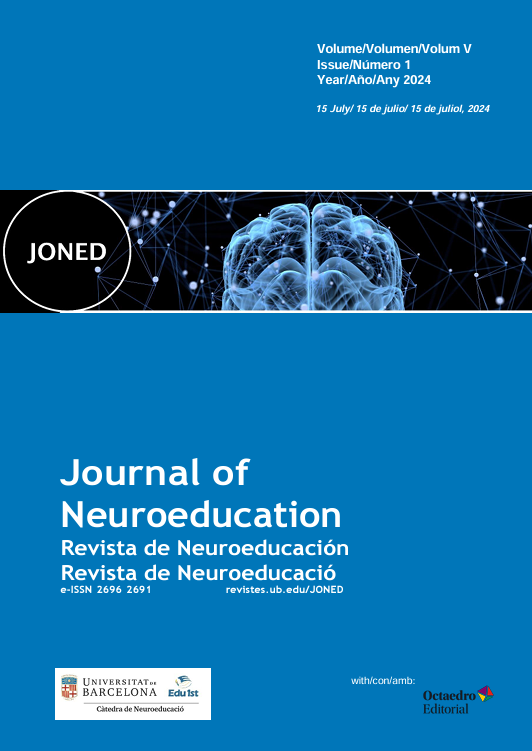El impacto de la Neuroeducación en el abordaje de las Necesidades Educativas Especiales: reforzando la inclusión con paradigmas actuales
DOI:
https://doi.org/10.1344/joned.v5i1.46269Keywords:
Neuroeducation, Special educational needs, Neuroscience, Neuromyths in education, LearningAbstract
Neuroeducation has gained special relevance in recent years. Based on this concept, which comes from Neuroscience, an attempt has been made to understand how human beings learn and what are the neurobiological foundations that support this process. The contributions of this area have been substantive, considering its interference in the field of Special Education, specifically in Special Educational Needs. This is how in this work an updated perspective on this conceptual relationship will be presented, starting with the origins of the concept of Special Educational Needs, the role of Neuroscience as the axis that directs the emergence of Neuroeducation and the role of the latter. as a guideline in the work that neurorehabilitation professionals carry out daily with the people with whom they work. Finally, a series of neuromyths will be revealed that are, in one way or another, linked to the work in Special Educational Needs and that contribute to considering realistic and updated perspectives with a view to strengthening the teaching and learning processes in people. that are in these conditions. In this way, it also seeks to generate a reflective and critical panorama regarding this relevant topic that, over time, has generated more and more impact on educational processes.
Downloads
References
UNESCO. Inclusión y Educación: Todos sin Excepción. Resumen Del Informe De Seguimiento De La Educación En El Mundo. 2020.
Macas C, Santos Jiménez ME. Inclusión educativa de las personas con Necesidades Educativas Especiales Permanentes. Revista Conrado. 2019;15(68):195–202.
3. Sevilla D, Martin MJ. Actitud del docente hacia la educación inclusiva y hacia los estudiantes con necesidades educativas especiales. Innovación Educativa. 2018;115–41.
Diamond M. Enriching heredity: The impact of the environment on the anatomy of the brain. Free Press; 1988.
Frick KM, Benoit JD. Use it or lose it: Environmental enrichment as a means to promote successful cognitive aging. ScientificWorldJournal [Internet]. 2010;10:1129–41. Disponible en: http://dx.doi.org/10.1100/tsw.2010.111
López C. Neuroeducación. Una propuesta educativa en el aula de clase. Bogotá: Ediciones de la U; 2016.
Bransford J, Brown A, Cocking R. How People Learn: Brain, Mind, Experience, and School. Washington, Estados Unidos: National Academy Press; 2000.
Hattie J. What Works Best in Education: The Politics of Collaborative Expertise. Londres: Pearson; 2015.
Armstrong T. El poder de la neurodiversidad. Paidós Ibérica; 2012.
Ortiz Zermeño O. Saber y saber enseñar. Revista Electrónica de Investigación Educativa. 2018;20(2):1–5.
Maturana H. Humberto Maturana y la naturaleza del hombre [Internet]. 2017. Disponible en: https://www.latercera.com/culto/2017/03/27/humberto-maturana-la-naturaleza-del-hombre/#:~:text=Los%20seres%20humanos%20somos%20seres,la%20naturaleza%20del%20ser%20humano.
Fernandez CI. La inteligencia emocional como estrategia educativa inclusiva. Innovación Educativa. 2011;21:133–50.
Bisquerra R. Educación Emocional y Bienestar. Barcelona: Editorial Praxis; 2000.
Monserrat R. La Neuroeducación en el Aula. [San Luis, Potosí]: Sistema Educativo Estatal Regular Dirección De Educación Inspección De Educación Normal Benemérita Y Centenaria Escuela Normal Del Estado; 2019.
Mora F. Neuroeducación. Sólo se puede aprender aquello que se ama. Madrid, España: Alianza Editorial; 2018.
Ortíz T. Neurociencias y Educación. Alianza; 2017.
Bergmann, R., Loor, G., Macías, A., Mora,A. Neurociencias y la Atención de las Necesidades Educativas Especiales en la Institución “Teresa Intriago Delgado”. Revista Educare Número Extraordinario. 2022;49.70.
Bortoli B, Teruya T. Neurociência e Educação: os percalços e possibilidades de um caminho em construção. Imagens da Educação. 2017;7 (1)(70–77).
Maldonado P. ¿Por qué tenemos el cerebro en la cabeza? Preguntas y respuestas sobre el sistema más complejo del universo? Santiago, Chile: Penguin Random House Grupo Editorial; 2019.
Newton P, Miah M. Evidence-based higher education- Is the learning styles “myth” important? Frontiers in Psychology. 2017;6 (1908):1-5.
De Bruyckere, P., Kirschner, P., & Hulshof, C. Urban Myths about Learning and Education. London: Elsevier; 2015.
Newton P. The Learning Styles Myth is Thriving in Higher Education. Front Psychol. 2015;6 (1908):1-5.
Kucian K, Grond U, Rotzer S, Henzi B, Schönmann C, Von Aster M.. Mental Number Line Training in Children with Developmental Dyscalculia. Neuroimage. 2011;57:782-95.
Downloads
Published
Issue
Section
License
Copyright (c) 2024 Norton Contreras Paredes

This work is licensed under a Creative Commons Attribution-NonCommercial 4.0 International License.
The authors who publish in this journal agree to the following terms:
a. Authors retain copyright and grant the journal the right of first publication
b. Texts will be published under a Creative Commons Attribution Non Commercial License that allows others to share the work, provided they include an acknowledgement of the work’s authorship, its initial publication in this journal and the terms of the license, and not for commercial use.



